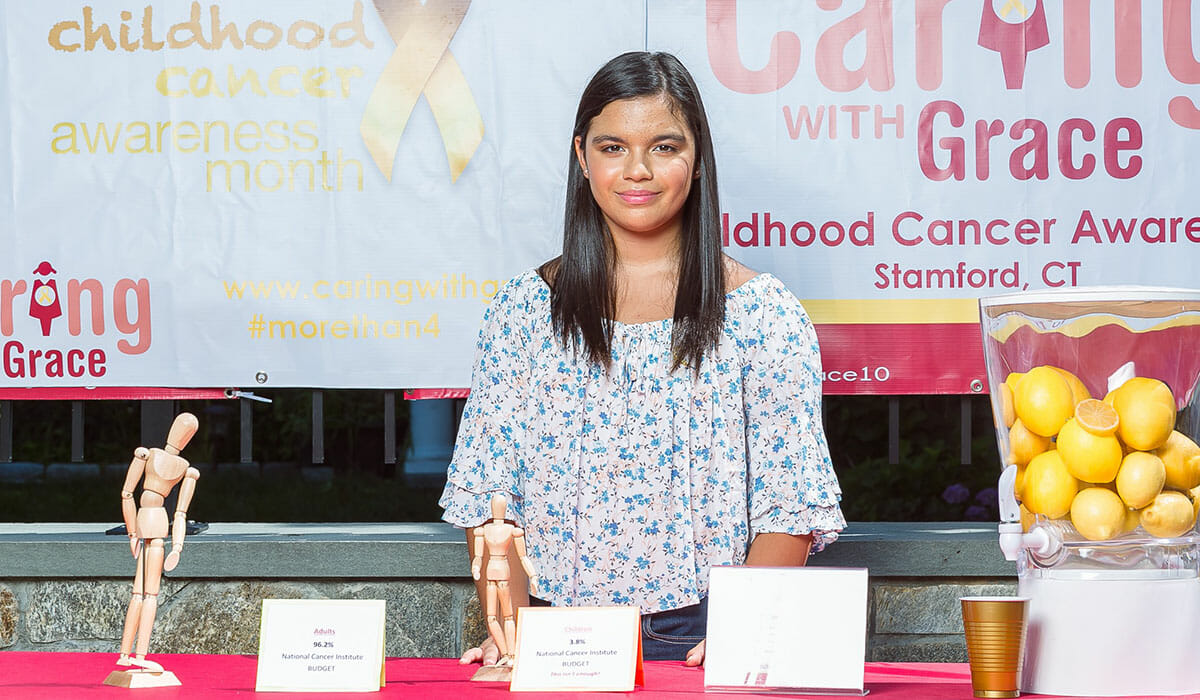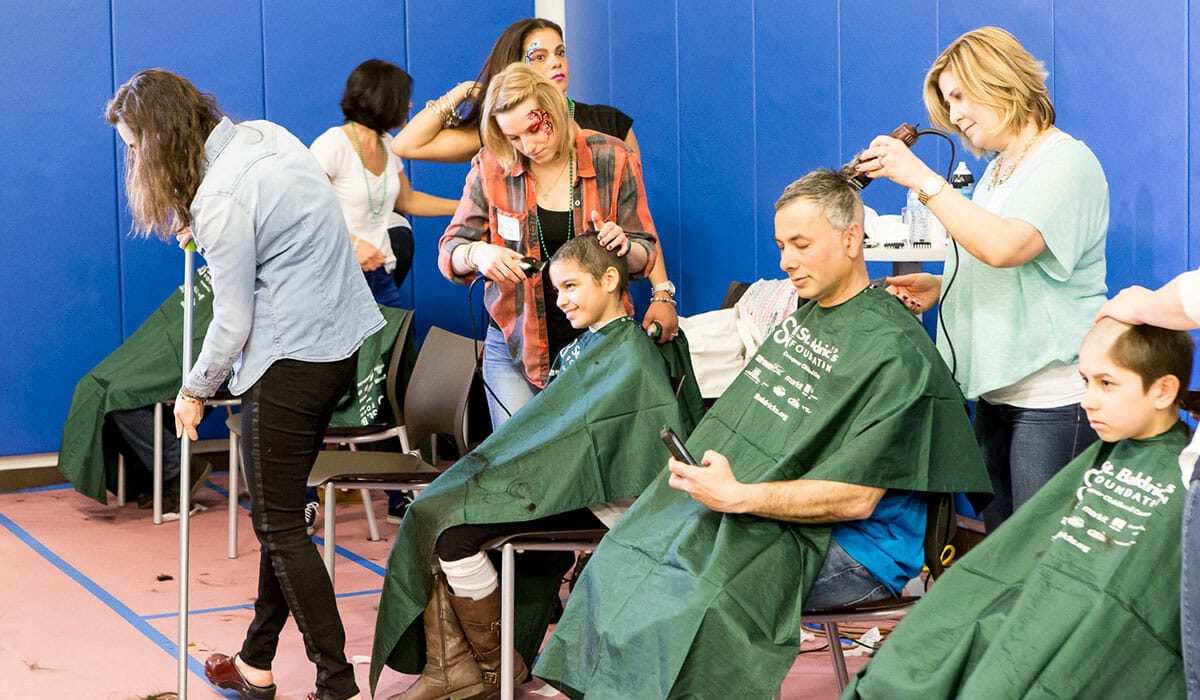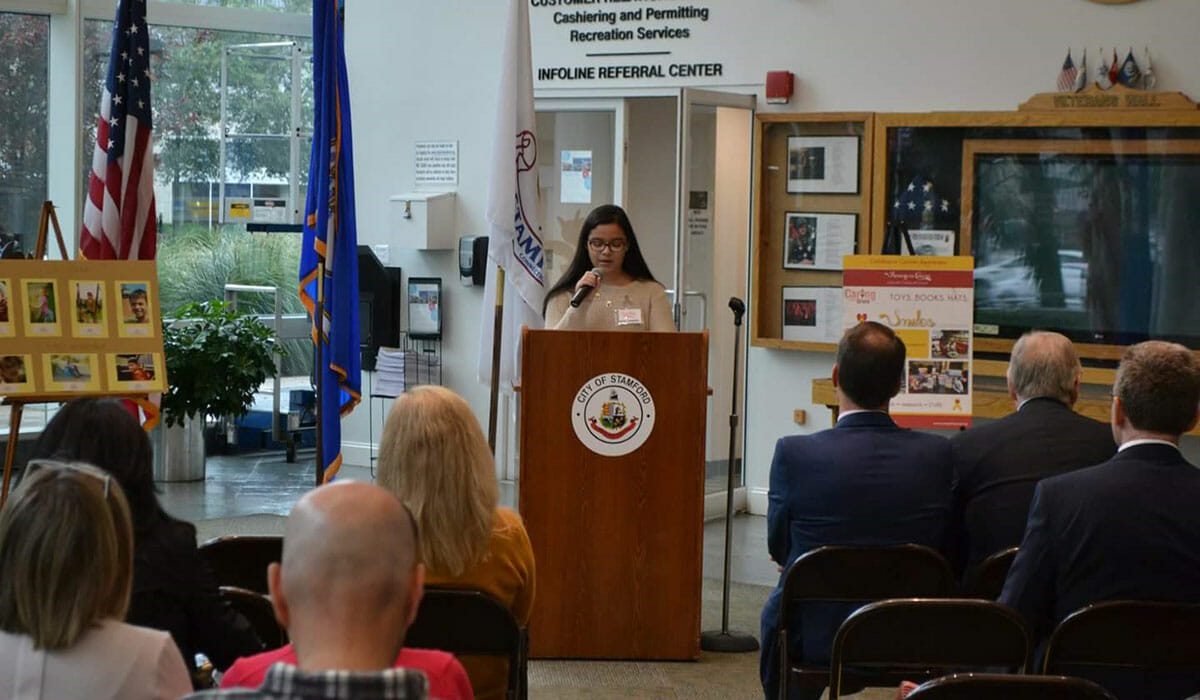Teenager Runs Nonprofit to Provide ‘Caring’ to Kids with Childhood Cancer and Their Families

Meet Daily Point of Light Award honoree Grace Targonski. Read her story and nominate an outstanding volunteer or family as a Daily Point of Light.
When Grace Targonski was ten years old, her aunt was diagnosed with breast cancer and her then-nine-month-old brother had brain surgery to remove a cyst. In the face of a devastating situation, Grace was inspired to make positive change for children with childhood cancer and their families. Now sixteen, she has run the nonprofit she founded, Caring with Grace, for over five years.
Caring with Grace focuses on easing some of the burden of childhood cancer patients and their families by providing care packages for the patients and their siblings, hosting free painting classes and other fun events for the families, volunteering at her local Ronald McDonald House, hosting awareness campaigns and more. About 10 to 15 volunteers help her with multiple events throughout each month. She has also taken the fight against childhood cancer a step further by not only raising money for childhood cancer research, but also traveling to Washington, D.C. several times a year to work on bills that would increase research funding and to meet with members of Congress.
“Some people are just thrown off or surprised when they hear I started this when I was ten, because they think I was too young to run a nonprofit,” Grace said, “but I just found my passion. It’s something that is very important to me and I don’t plan on ever stopping.”
What is Caring With Grace?
We are a nonprofit and we focus on childhood cancer. We send packages with toys, books, hats and cards, not just to the patients, but to the siblings if they have any. We stay connected throughout the treatments and over the years for holidays and birthdays. We also have programs. There’s free painting classes for those families effected by childhood cancer along with things like haircutting events, where a salon will host it and people come and donate their hair and will get a free hair styling at the end of it. Then we take the hair and send it to a group called Wigs for Kids, and they make wigs and donate them to children with cancer. I do a lot of advocating work as well. Over the past five years I’ve been working on three bills that will help the childhood cancer community with its funding. I go to Washington, D.C. around five times a year for these meetings and I meet with congressmen to talk about the bill and such. We do a few different things but it’s all about childhood cancer.
Describe your volunteer role with Caring With Grace.
I am the founder. I founded it when I was 10 years old and it’s been about five and a half years now. I have a lot of volunteers but I’m the one dealing with the emails, getting connected with people. I have people reach out to me when they hear of families that have a child that was diagnosed. Along with my volunteers, we’re the ones who go out and we buy supplies for things we need for the packages and put them in the packages and send them out personally. I’m the one who goes to the meetings. I do all of the stuff behind the scenes but it’s mostly me and my mom doing that, and then my volunteers help out with public events.

What inspired you to start this nonprofit?
Back in 2012, my aunt was diagnosed with breast cancer and right before her diagnosis, my little brother, who was nine months old at the time, was told he had to have brain surgery because he had a brain cyst. I remember they told me a cyst isn’t cancerous and we won’t have to worry about him having any type of brain cancer. I believe it was my curiosity that I had questions about the difference between childhood cancers and adult cancers. I had questions that people didn’t really have the answers to, so that led to me finding my own answers and researching on the Internet. A bunch of things popped up about nonprofits and how the funding is really low for childhood cancer, so at that point it kind of became a no brainer that I should do something about it. I started by just having a hat drive in my school and I donated it the [Yale] New Haven Hospital. After that, a passion sparked and I realized this was something I wanted to do longterm. Because of all the support I had from my family and friends, we were able to grow really quickly. It’s been over five years now and we have our nonprofit status.
What inspired you to start sending the packages?
The first thing I did to help the childhood cancer community is I reached out to this nonprofit in Virginia and what they do is they send hats to children with cancer. When I asked them how I could help, they told me I could set up my own hat drive so that’s what I did. After that, I wanted to do more and I wanted to make it kind of customized. I figured that everyone likes toys and I was always really big on reading so I wanted to include books in the packages, and not just for the patients, but for the siblings as well. I wanted to give them something to do while they were in the hospitals or in the waiting rooms. I came up with these three things initially and eventually I started adding cards made by other children. At some events I’ll have a table and kids and parents will come and make cards for a child with cancer or a sibling of the patient. They will be included in the packages as well, along with anything else the family will need. Sometimes I will ask them for specifics and I will try to help them out to the best of my ability.
Why did you also want to include the patients’ siblings?
Seeing my brother go through brain surgery and his recovery. I’m the oldest out of three and I kind of had to grow up very quickly and help out with my younger sister and I had to become very independent at an unexpected time. Something that some people don’t really see is when a child is diagnosed with cancer and they have other siblings, the parent has to go through so much for the sick child in the treatments, that the siblings are going through a tough time and don’t always have the support system that they really need. I didn’t want them to feel they’ve been forgotten because I know just a little bit of what it’s like having a sibling who is sick and how hard it can be. I wanted to include them so they know we’re thinking of them as well.
Why is it important for there to be continued funding for childhood cancer research?
What a lot of people don’t know is that the funding for childhood cancer research is very low. The National Cancer Institute breaks up its budget between adult cancers and childhood cancers. Adult cancer research gets 96.2 percent, which leaves kids with only 3.8 percent. They get less than four percent of the NCI budget. Kids get different cancers than adults … and especially since a child isn’t fully developed, it’s very different cases with each child, even if it’s the same type of cancer. There is just a lot we don’t know about the human body in general and especially when these kids aren’t done growing, it’s so hard to tell what kind of medicine they need, what kind of amount. Since we don’t have the funding to do the research and get the technology and to get the medication, a lot of these children are suffering and they’re either taking really old and really toxic medicine, or they’re taking adult medicine. Everyone sees the side effects they have on adults and it’s pretty brutal, so imagine what it’s like giving [the medicine] to a young child or sometimes even a baby. If a child is sick, you won’t give them cold medicine that’s meant for adults, there’s medicine that’s made for children and it’s for a reason.
We need this funding to have this research done so we can better understand how to help these children and to get them better resources because their life is dependent on it.

Are there any future partnerships, programs, or events that you are excited about?
I go to the Ronald McDonald House up to maybe five times a year. We have this program, Day of Kindness, and I bring a chef, musician, artist, a bunch of my volunteers and my friends. The families who stay at the Ronald McDonald House, their child typically has to go under some major surgery or treatment and [the child] stays at the hospital that’s right across from the House. They come from all over. I know a family from Venezuela that comes over once a year for treatment and they stay at the house. I go there a few times a year and I bring all these people and for a whole day, we’re there serving food and entertaining and the adults hang out with the adults and the kids hang out with the kids. It’s always a really good time and a successful event. We bring donations for the house and things like that. I’m always looking forward to that one and that will be coming up in the next couple months.
What’s been the most rewarding part of your work?
Something that’s happened to me a few times is the parents will reach out to me. Sometimes the child is still in remission, sometimes the child is still in treatment or the child has passed away. I’ve had parents reach out to me and tell me how the things I do aren’t so small in their eyes. The little packages, I just think of them as a simple way to make someone’s day better, but they really see it as something else from their perspective. They’ll come to me and they’ll tell me how grateful they are. I don’t really think of that when I do these programs or these ideas that I come up with, so it’s kind of cool to see how I actually do have an effect on these families and it definitely kind of opened my eyes to realize what’s actually going on.
Why do you think it’s important for others to give back?
There’s a lot of issues in the community besides childhood cancer and us ignoring them and just thinking, ‘Oh, but they don’t affect me directly so I don’t have to do anything about it,’ it’s not benefiting anyone. It’s very important for us to work as a team and start acting like a community. We need to address these problems and find solutions or nothing is going to be done. There’s a lot of work to do, not just with childhood cancer but with other things. If we worked together and had this common goal, it would be easier to reach those goals.
Do you want to make a difference in your community like Grace? Find local volunteer opportunities.
